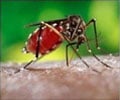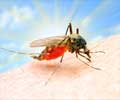Dengue virus origin does not depend on the multiplication rate rather on the virus capability to trigger weaker activation of patient's immune response.

‘The genealogy of dengue virus predominates even though it multiplies less because one lineage of the virus replaces another by triggering weaker activation of the patient's immune response.
’





According to the study, the lineage activates a weaker immune response in the patient and is less strongly combated. As a result, the virus is able to multiply more in the organism and is more likely to be transmitted to others via infected mosquitoes, so that this lineage supersedes the other owing to its significantly greater overall capacity to multiply in mosquitoes and patients.The researchers studied lineages 1 and 6 (L1 and L6) of type 1 dengue, which affects the population of São José do Rio Preto, São Paulo State, Brazil.
Their findings showed that while L1 had a superior capacity to multiply in mosquitoes and cells, L6 was able to minimize and even deactivate the human immune response, so that this lineage ended up replacing L1.
"There were three approaches to investigating the situations in which dengue virus multiplies and to explain why one lineage supersedes another.
Our research brought to light a new phenomenon that explains how a virus survives in a population," said Maurício Lacerda Nogueira, a professor at the São José do Rio Preto Medical School (FAMERP), head of its Dermatological Disease Department's Virology Research Laboratory, and co-author of an article that published the results of the study in PLOS Neglected Tropical Diseases . Nogueira also chairs the Brazilian Society for Virology.
Advertisement
The study produced vital new knowledge for the production of dengue vaccines. "A global understanding of how the virus interacts with the population helps us understand how vaccines work and are fundamental to our ability to design them," he said.
Advertisement
L1 was expected to display a higher capacity to multiply in cells and the vector mosquito, Aedes aegypti, since it arrived after L6 and its viral fitness appeared to be superior to that of L6. L1 was therefore expected to replace L6 as the dominant strain, but it began to decline in 2013 and eventually disappeared.
This fact contradicted existing scientific knowledge about the prevalence of one lineage over another - a phenomenon called clade replacement (a clade is a branch of a phylogenetic tree comprising all organisms that have evolved from a common ancestor).
Clade replacement occurs if a lineage multiplies more in human cells after being introduced than another lineage that was already living in the same environment, or if a lineage that arrives later multiplies more in the mosquito. In both cases, the lineage that supersedes the other is said to have a higher level of viral fitness.
Epidemiological fitness
A third explanation arose from a 2015 study conducted in Puerto Rico, where a lineage of dengue virus was found to have a lower level of viral fitness than the lineages that were already in the environment yet eventually replaced them. Scientists discovered that this lineage inhibited the interferon system, which acts as the first line of defense against viruses in mammals (interferons are a complex of proteins that interfere with viral replication and protect cells from infection).
This phenomenon is called epidemiological fitness the capacity of a virus to become dominant in the field during epidemic outbreaks.
In the Brazilian case, none of this happened. The researchers first sequenced the genomes of the two viral lineages, which were found to have 47 different amino acids. Despite this significant genetic distance, L6 won the competition between them.
"Based on the information available at the time, it was assumed that L6 multiplied better and therefore became dominant, but when we looked at contaminated human and monkey cells, we found that L1 multiplied ten times more on average than L6," said the coordinator for the FAPESP Thematic Project.
The next hypothesis was that L6's higher viral fitness might be due to its higher multiplication rate in the mosquito. The researchers therefore infected captive mosquitoes (bred for use in scientific experiments) orally, having them feed by biting a membrane that contained mouse blood contaminated with dengue virus L1 and L6. "Again, L1 multiplied ten times better than L6 in the mosquito," Nogueira said.
The researchers then investigated the possibility that the captive mosquitoes were somehow different from those found in the environment. In a new experiment, mosquito eggs were collected in the environment and hatched in the laboratory. The result was the same: L1 continued to be more efficient than L6 regarding multiplication, although studies showed that patients infected with L6 had a far higher viral load than those infected with L1.
This evidence left the epidemiological fitness hypothesis, as had been the case in Puerto Rico, where a dengue virus that encoded interferon-inhibiting RNA had been found. Interference was not confirmed in the Brazilian case. "We then realized we were dealing with a mechanism that differed from the three known ones," Nogueira said.
To solve the mystery, the researchers began studying the immunological aspects of the virus's interaction with the organism.
Using computational prediction systems, they found that L1 was far more likely than L6 to activate B and T lymphocytes, the main cellular components of the adaptive immune response.
Next, in studies involving mice and cells donated by people infected with the virus, the scientists succeeded in stimulating and measuring the activation of the response by B cells and T cells, observing that L6 activated a weaker response than L1. They also measured the level of cytokines present in the patients' serum. Cytokines are signaling molecules that mediate and regulate immunity.
"Generally speaking, we observed that L1 multiplies much better but also strongly activates the immune system in both humans and mice," Nogueira said. "In other words, L1 induces a very robust response against the virus by the organism, whereas L6 multiplies less but either inhibits the immune response or stimulates it little or not at all, so the organism takes longer to recognize the virus."
As a result, the number of L6 viruses in the human organism is tenfold the number of L1 viruses on average, found the FAPESP-supported study. They also observed that L1 multiplies much more in the mosquito and replicates far more locally when it infects a person. This vigorous replication triggers strong activation of B and T cells, leading to an increase in cytokines, and this strong immune response inhibits systemic replication by the virus in the organism. As a result, the viral load is lower, and dissemination to mosquitoes is reduced so that fewer people will be infected by L1.
Despite the lower capacity of L6 to multiply in the mosquito and at the site of initial replication after a person is bitten, it produces only weak activation of B and T cells and stimulates the secretion of cytokines that inhibit the immune response instead of stimulating it.
"So systemic replication in people is much greater," Nogueira said. "This means the number of viruses in the population is higher, and more mosquitoes will be infected. We, therefore, concluded that the epidemiological fitness of L6 is higher than that of L1, whereas the viral fitness of L1 is higher than that of L6."
The research lasted two and a half years and involved a group of 24 scientists at several Brazilian higher education institutions in addition to FAMERP - Oswaldo Cruz Foundation, the Federal Universities of Rio de Janeiro (UFRJ) and Minas Gerais (UFMG), and São Paulo State University (UNESP) - as well as foreign collaborator Nikos Vasilakis, also a coauthor of the article and a researcher at the Center for Tropical Diseases, University of Texas Medical Branch, in Galveston (USA).
"Using epidemiological, phylogenetic, molecular and immunological analysis, the authors of the research showed that differences in the host's immune response determine the dynamics of circulation in two lineages of dengue virus found in the city, suggesting that the factors that influence the dynamics of dengue transmission are far more complex than was previously thought," Vasilakis said.
Source-Eurekalert













